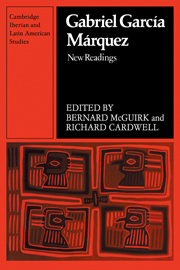Book contents
- Frontmatter
- Contents
- Note on the translations
- List of contributors
- Introduction
- 1 Characterization in the early fiction of Gabriel García Márquez
- 2 Beware of gift-bearing tales: reading ‘Baltazar's Prodigious Afternoon’ according to Marcel Mauss
- 3 The body as political instrument: communication in No One Writes to the Colonel
- 4 Magical realism and the theme of incest in One Hundred Years of Solitude
- 5 Translation and genealogy: One Hundred Years of Solitude
- 6 The humour of One Hundred Years of Solitude
- 7 On ‘magical’ and social realism in García Márquez
- 8 Aspects of narrative structure in The Incredible and Sad Story of the Innocent Eréndira and her Heartless Grandmother
- 9 Language and power in The Autumn of the Patriarch
- 10 Writing and ritual in Chronicle of a Death Foretold
- 11 Free-play of fore-play: the fiction of non-consummation: speculations on Chronicle of a Death Foretold
- 12 A prospective post-script : apropos of Love in the Times of Cholera
- The solitude of Latin America: Nobel address 1982
- Select bibliography
- Index
8 - Aspects of narrative structure in The Incredible and Sad Story of the Innocent Eréndira and her Heartless Grandmother
Published online by Cambridge University Press: 05 November 2011
- Frontmatter
- Contents
- Note on the translations
- List of contributors
- Introduction
- 1 Characterization in the early fiction of Gabriel García Márquez
- 2 Beware of gift-bearing tales: reading ‘Baltazar's Prodigious Afternoon’ according to Marcel Mauss
- 3 The body as political instrument: communication in No One Writes to the Colonel
- 4 Magical realism and the theme of incest in One Hundred Years of Solitude
- 5 Translation and genealogy: One Hundred Years of Solitude
- 6 The humour of One Hundred Years of Solitude
- 7 On ‘magical’ and social realism in García Márquez
- 8 Aspects of narrative structure in The Incredible and Sad Story of the Innocent Eréndira and her Heartless Grandmother
- 9 Language and power in The Autumn of the Patriarch
- 10 Writing and ritual in Chronicle of a Death Foretold
- 11 Free-play of fore-play: the fiction of non-consummation: speculations on Chronicle of a Death Foretold
- 12 A prospective post-script : apropos of Love in the Times of Cholera
- The solitude of Latin America: Nobel address 1982
- Select bibliography
- Index
Summary
I am going to begin with beginnings. Each story in ISS begins with an arrival – a space or a consciousness is invaded by an unknown presence. But the nature of the invading presence differs: in ‘Constant Death’ and ‘Blacamán’ it is human (Onésimo Sánchez and Blacamán respectively); in ‘Very Old Man’ it is part-human (the bird-man); in ‘Drowned Man’ it was formerly human (Esteban's corpse); in ‘Sea’ and ‘Incredible Story’ it is a natural phenomenon (the smell of roses and a wind respectively); and in ‘Last Journey’ it is an object (the ghost ship). But in four of the stories the source of the invading presence is the same: in one way or another, the sea is associated with the arrival in ‘Very Old Man’, ‘Sea’, ‘Drowned Man’ and ‘Last Journey’, and in the first two of these the invading presence returns to the sea at the end. And in all of the stories the arrival has the same extraordinary effect – it becomes the focus of widespread, sometimes all-absorbing, attention – and in each case the arrival represents the inception of a series of events that will occupy the remainder of the story. The effect of the arrival is to disrupt – it introduces instability into a pre-existent situation, and that instability produces interest and also movement. The interest stimulated by the new arrival centres on a common reaction in several stories: the need to discover the meaning of the disruption.
- Type
- Chapter
- Information
- Gabriel García MárquezNew Readings, pp. 117 - 134Publisher: Cambridge University PressPrint publication year: 1987

